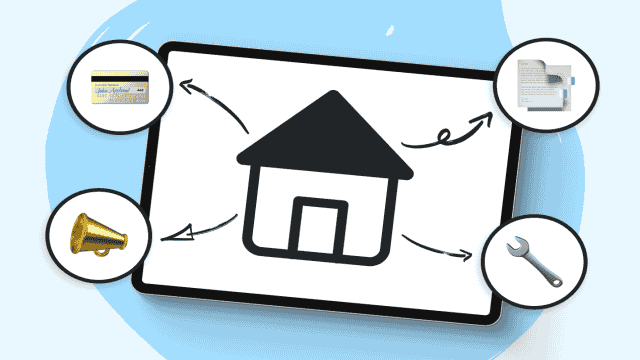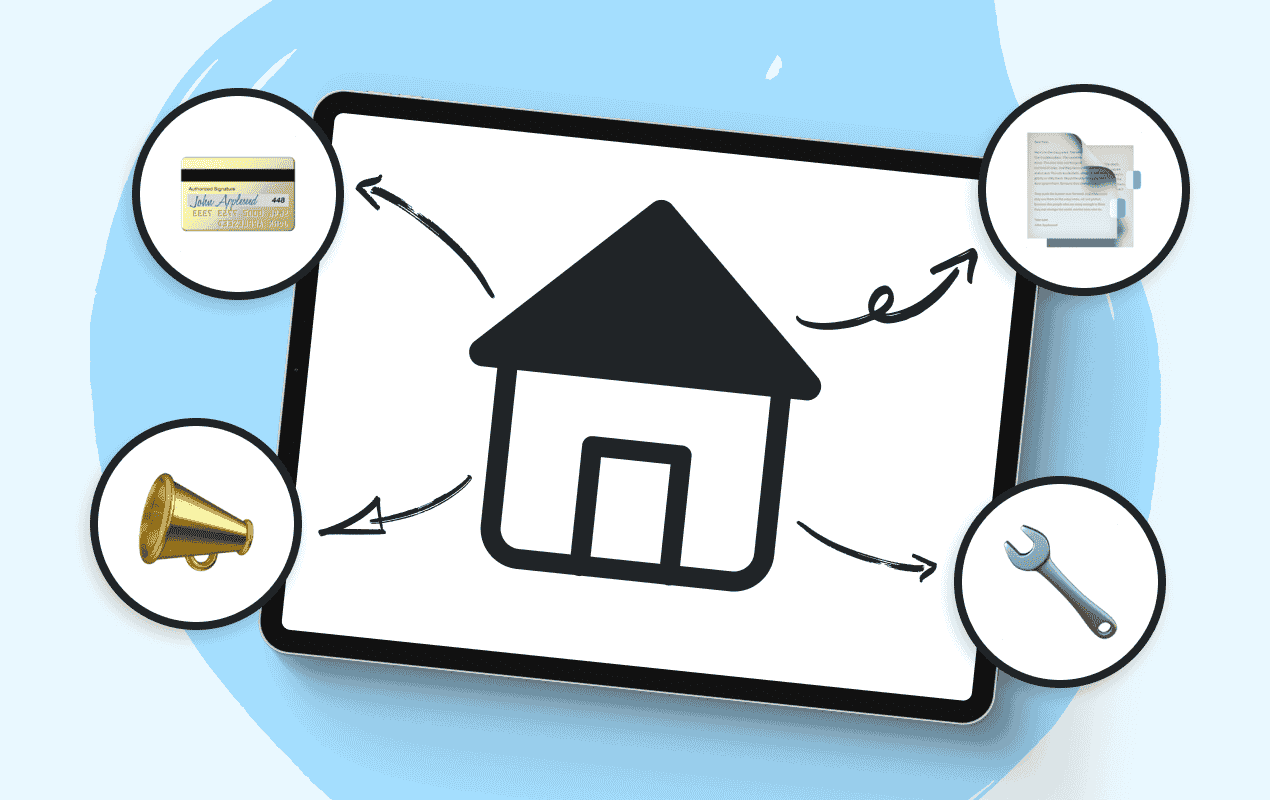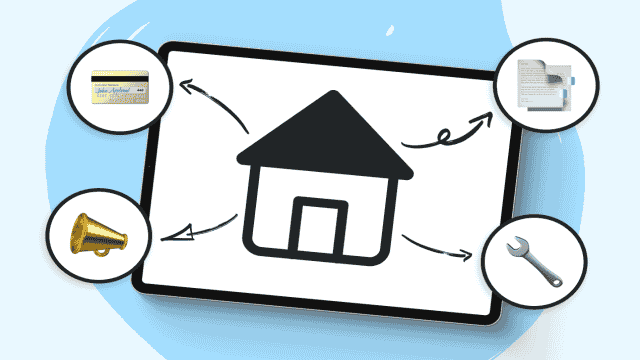
Managing real estate properties is a complex task. Not only do property managers have to deal with constantly evolving political regulations and new requirements for rental management, they also have to handle a significant amount of paperwork, documents, and Excel spreadsheets. From rental agreements to utility bill calculations and house rules, property managers constantly need to gather all the necessary data and quickly adapt to new decisions, such as rent control measures. Moreover, communication with all parties involved often tends to be sluggish.
Furthermore, property managers face additional challenges due to the rise of remote work and home office. They have to efficiently work with documents and data remotely, and are often confronted with requests for rent deferrals. Both private property managers and large property management companies often find themselves in chaotic situations. Multiple physical document archives or different file versions contribute to significant time loss.
Luckily, the right software for property managers can provide a solution. However, many property management companies have not yet invested in a suitable software solution that can provide the necessary support. At CAYA, we wondered why this is the case, considering that digitalisation is already prevalent in property management.
Our comparison guide is intended to show property managers – from individual landlords to large property management companies – what software solutions are available for property management. We have highlighted the advantages of using connected tools in your daily work as a property manager and provided tips on choosing the right software. Purchasing software for online property management should be carefully considered, as it creates dependencies in workflows. Switching to another software solution later on can be a time-consuming process. That’s why we have also explored the distinguishing features and functionalities of different providers and provided tips for successful software implementation.
1. How Can Property Management Software Help?
Property management software can streamline the work of both rental and condominium managers. However, since their duties vary, managers need to carefully consider which functions they require when selecting the appropriate software.
Different types of managers require different functionalities. For example, condominium managers are responsible for organizing annual general meetings and preparing annual utility bill statements for owners. On the other hand, rental managers need to handle both administrative and technical tasks, such as:
- Creating tenant profiles and managing rent payments
- Acting as a point of contact for tenants and sending reminders or warnings, for example
- Managing contracts and invoices
- Preparing utility bill statements for tenants
So, in which areas can the right software provide assistance?
Support for Daily Bookkeeping:
- Keep track of rental billing, income, and expenses
- Automate cost tracking, rental income, security deposits, and billing by linking the software to your bank account
- Generate operating and heating cost statements
- Automate the compilation of all necessary information for tax return form V
Annual Utility Bill Statements:
- Create legally compliant statements
- Generate statements quickly by linking income and expenses within the software
- Include tenant prepayments in the statements
Performance Indicators:
- Monitor rental yield, water consumption, or vacancy rates
- Gain an overview of key performance indicators and meter readings
Service Provider Management:
- Manage facility management tasks such as maintenance, cleaning, and gardening
- Document tasks and assignments
Centralized Communication:
- Utilize a centralized digital channel to inform tenants or owners
- Stay up-to-date with real-time information on, for example, the status of damages
Archiving:
- Digitize document management, allowing access to current contracts and other documents anytime, anywhere
Tenant Management:
- Organize data (e.g., rental agreements) and manage addresses effectively
- Store rental agreements and documents
- Assign allocation keys to distribute costs
New Tenancy:
- Perform digital property inspections
- Quickly create rental listings on portals
- Manage rental applicants
By the way: For our research, we conducted interviews with Andreas Schneider (immocloud) and Peter Schindlmeier (casavi) in addition to studying relevant literature. You can find these interviews as videos or podcasts linked in our magazine article on property management software.
2. The Benefits of Digital Property Management
Property management software is no longer limited to simply managing property and tenant data. Thanks to software solutions, property managers can cover a wide range of tasks and bridge the digital gaps in property management.

Efficient Document Management: Enhanced Overview and Service
Digital document management and archiving simplify the process. Property managers can provide digital copies of management documents, ensuring easy access and flexibility. This also applies to self-generated documents such as rental agreements. With digitized tenant files, property managers can work more efficiently, even from home offices. Moreover, this improves the service factor – tenants have access to relevant information such as statements at any time.
Streamlined and Effective Correspondence
Analog processes become even more cumbersome when property managers work remotely. Dealing with physical mail or sending and receiving traditional letters during remote work can be time-consuming and laborious. Property management software can alleviate this burden by digitizing incoming correspondence and efficiently routing it to the right recipients. To further digitize the management of physical mail, CAYA can redirect your postal mail to our scanning centers, where it will be digitized. With CAYA, you can not only receive your mail conveniently online but also manage and process it directly in our Document Cloud. It offers a centralized location for managing your documents: post-digitization and document management from a single source.
Location-Independent Cloud-Based Work
Digital document management already simplifies remote work, allowing property managers to access tenant files without the need for physical folders. Cloud-based property management software enables quick and easy access to all documents. Additionally, mobile apps or web access provided by rental management software enable property managers to work from anywhere.
Automation: Faster, Easier, and Cost-Effective
Cloud-based property management reduces the time and effort required for various tasks. Consider the daily processing of incoming invoices, which often arrives as paper mail. Typically, invoices need to be manually registered, stamped, sent to the appropriate reviewer for approval, and then entered into property management software or an Excel spreadsheet. Professional property management software automates these processes. Digital documents are easily searchable, shareable, editable, and automatable.
Quality Assurance through Consistent Processing Standards
In a property management software, property managers can standardize and automate processes. This applies to invoice management as well as property inspections. Consistent processing standards result in fewer inquiries about processing status. Moreover, digital documentation facilitates smoother communication with contractors and tax advisors, for example, in repair management or utility bill statements. Central data storage optimizes data quality. The ease of use provided by property management software often convinces even well-established property management companies.
Boosted Data Protection through Digitalization
Data protection and compliance with the General Data Protection Regulation (GDPR) and personal data handling rules are challenging for every industry. Property management software can help comply with data protection regulations. Digital data storage makes data handling easier and less prone to errors. For more streamlined administration, data can be quickly erased when there is no legal obligation to retain it. Digital documentation also enables property managers to prove compliance with relevant regulations by digitally recording their processing activities. This is particularly important for larger property management companies that often have documentation requirements.
3. Checklist: Requirements for Property Management Software
Choosing the right property management software depends on individual needs. The tasks involved in managing rental properties can vary widely. There is often no single best property management software solution. To find the most suitable program for your needs, managers must compare different options and consider their specific requirements. It’s important to analyze and define your processes and minimum requirements before comparing different property management software solutions.
Property managers can objectively compare different property management software solutions by creating a detailed requirements catalog. However, there are general criteria that apply to all property management software comparisons, despite individual differences.
4. Best Practices for Software Selection
We recommend creating a detailed digitalization concept. Determine which documents and folders should be digitized. Which data needs to be transferred? Perhaps the new property management software offers automatic import of invoices or data from existing systems?
To ensure software acceptance and usage, it is important to clearly communicate why a new software solution is being introduced and what problems it aims to solve. It is also crucial to involve all stakeholders before purchasing software. Not everyone has the same level of digital affinity, and extra support may be needed.
Providing appropriate training measures for employees can help them adapt to the new property management software and increase digital competencies. Training can be conducted by external service providers or internal trainers who have been trained in advance. Property management software providers often offer excellent support, training videos, and FAQs.
Discussing new roles and workflows is also essential. Established workflows will change, and new roles and processes need to be defined. Property managers should consider customer requirements as well. For example, digital damage reports that all users can access and view in real-time can benefit all stakeholders. Therefore, customer requirements should also be taken into account.
Additionally, it may be beneficial to consult other experts such as process consultants, data protection officers, or even lawyers. Legal advice may be necessary, especially when a property management company is required to publicly tender its services.
When selecting a software solution, some requirements may carry more weight than others. It is especially important to ensure that all stakeholders can understand and easily access important data.
You can also contact selected software providers to discuss your requirements and request software demonstrations. Testing the software can provide valuable insights. Many providers offer free trial versions. Property and real estate managers should take their time and make wise choices. Implementing a new system can lead to dependencies and lock-in effects, making it difficult to switch to another software solution.
5. Property Management Software Comparison
Which property management software is right for you? Every property management company and property has unique and specific requirements. Therefore, there is no one-size-fits-all property management software. However, there are tools and providers that offer extensive features and go beyond the minimum requirements of property management. Our analysis highlights the best property management software solutions available. We examine comprehensive software packages with many features as well as specialized software solutions for specific processes.
5.1 All-in-One Property Management Solutions
Some software solutions position themselves as all-in-one packages or software suites. Their range of features goes far beyond core accounting tasks. They often include various modules for communication, portals, and task management. Of course, not every solution can cover all aspects of property management. The key is to consider what is truly needed and what can be modularly expanded later on. We have examined the most relevant providers:
5.2 Specialized Software for Property and Real Estate Managers
Many property management companies have already digitized certain aspects of their operations. Therefore, it may not always be necessary to adopt a completely new solution or an all-in-one suite. However, individual processes can still be optimized. Tools that specialize in accounting, cost management, or utility bill calculations can help streamline administrative processes and automate tasks. Communication tools for tenants or service providers can also greatly facilitate day-to-day operations.
By the way: 💡💌 Interested in more information on managing your postal mail? Which documents still need to be kept in paper form? What are the retention periods? Subscribe to our newsletter and receive monthly updates on document management.
6. Successfully Implementing Property Management Software
Simply selecting a digital tool is not enough to ensure relief and increased efficiency. The implementation of property management software must be well-planned. Implementing an all-in-one software requires more extensive implementation than a specialized solution. Nevertheless, there are several important steps that apply universally. Here are 6 points to consider:
Develop a digitalization concept: Before introducing new software, it is essential to identify which documents and folders should be digitized. What data needs to be transferred? Perhaps the new property management software offers automatic import of invoices or data from existing systems?
Articulate the “Why”: To achieve software acceptance and adoption, all stakeholders must understand why a new software solution is being introduced and what problems it aims to solve.
Communicate early: Involve all parties who will interact with the software even before purchasing it. Not everyone has the same level of digital affinity and may require additional support.
Incorporate training measures: Appropriate training measures for employees will support the adoption of the new property management software and increase digital competency. Training can be provided by external service providers or internally trained representatives. Property management software providers often offer excellent support, training videos, and FAQs.
Discuss new roles and workflows: Established workflows will change, and new roles and processes need to be defined. Consider who will be affected by the changes and anticipate potential challenges.
Designate software advocates within the company: Selected employees can act as software evangelists, serving as points of contact for questions, providing training, and keeping stakeholders informed about next steps. By the way, you can find the full-length interviews with Peter Schindlmeier (casavi) and Andreas Schneider (immocloud) in video format in our magazine article.
7. Property Management and Legal Considerations
Managing rental or condominium properties involves rights and obligations. Although the new version of the German Condominium Act (WEG) that came into effect on December 1, 2020 does not provide an exhaustive list of obligations for property managers, it does require them to take measures for the proper administration of the community of apartment owners. While there is no legal requirement to use property management software, property managers are expected to engage in proper property management.
Disputes between property managers and tenants or owners can lead to legal action. Property managers are liable for damages, and disputes can escalate to court proceedings. Owners may demand access to documents and records, and failure to meet deadlines may lead to legal action or even termination and dismissal. According to §26 (3) No. 1 of the German Condominium Act (WEG), owners can dismiss a property manager at any time, without good cause. Dissatisfaction alone is sufficient for dismissal.
Digital property management offers support in creating accurate and legally compliant annual or utility bill statements. Many software providers keep their solutions up to date with the latest rental laws and regulations. Templates for legally secure contracts or tax return forms contribute to increased legal certainty. The digital document management provided by property management software often meets the requirements of the German Federal Ministry of Finance’s guidelines for proper bookkeeping and record keeping in electronic form (GoBD). CAYA is already GoBD certified. By following GoBD guidelines, companies are well-prepared for tax audits. Compliance requires ensuring the completeness, correctness, order, and immutability of documents. If you want to prove your own GoBD compliance and check whether you work in a GoBD-compliant manner, you can download our questionnaire.
8. IoT: Property Management Software and Smart Home for Streamlined Operations
Digitalization is not the only trend in property management – the Internet of Things (IoT) has also made its way into property management. Data collection is used in industry and the private sector to optimize maintenance and costs.
In property management, remote control of energy consumption and the use of smart meters to monitor utility usage are already widespread practices. Computer-aided facility management (CAFM) software is also frequently used to reduce ongoing costs in building management. Current damage reports or similar inquiries are usually reported by people. However, property managers already using property management software can save several administrative steps when communicating with tenants. By leveraging predefined threshold values in data, automated notifications can be sent, eliminating the need for manual reviews and dispatching.
In the future, the possibilities and applications will increase. Tenants and owners will expect additional IoT services from property management. The idea is that objects can report their own damages, and repair orders can be immediately visible in the appropriate software. This brings benefits to all parties involved since the status of damages is instantly accessible.
9. Conclusion
Our comparison shows that Excel is no longer the go-to solution for property management, whether for large property management companies or private landlords. Property management software supports managers in tasks such as utility bill statements, monitoring rental payments, and digital document storage. It facilitates bookkeeping, financial management, and meter management. It also provides property managers with legally secure templates and enables them to work with future-proof systems.
However, digitalization is not an end in itself. Companies can easily get lost in the numerous features offered by property management software. Which property management software is the best? Property managers can answer this question by comparing the presented providers with their requirements. To truly enjoy the benefits and increase efficiency, property management companies should follow industry best practices, which we summarize here:
- Take a structured approach and take your time.
- Perform a thorough analysis of your current processes and define goals.
- Create a detailed requirements catalog and compare providers.
- After selecting a software solution, digitize selected processes, train employees, and, if necessary, integrate the new property management software with accounting or ERP systems to avoid duplicate data storage.
By the way, you can find the full-length interviews with Andreas Schneider (immocloud) and Peter Schindlmeier (casavi) in video format in our magazine article on property management software.
We wish you success in selecting and implementing the right property management software for your needs. Best regards, Your CAYA Team.
By the way, would you like to take a detour? 🎙️ In our podcast interview with Raphael Thelen, Vice President Finance at McMakler, we discuss how CAYA automation and digital process integration help the finance department at McMakler streamline operations and reduce the workload for employees.

